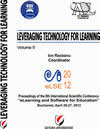ASPECTS OF SERIOUS GAMES CURRICULUM INTEGRATION - A TWO-FOLDED APPROACH -
ASPECTS OF SERIOUS GAMES CURRICULUM INTEGRATION - A TWO-FOLDED APPROACH -
Author(s): Pablo Moreno Ger, Michela Ott, Jeffrey Earp, Ion ROCEANU, Maria-Magdalena PopescuSubject(s): Education
Published by: Carol I National Defence University Publishing House
Keywords: Serious games; curriculum integration; pedagogy; psychology
Summary/Abstract: Over the years, there have been numerous definitions of curriculum integration,where the curriculum is interwoven, connected, thematic, interdisciplinary multidisciplinary, correlated, linked and holistic.[1] Curriculum integration is based on both philosophy and practicality, drawing together knowledge, skills, attitudes and values from within or across subject areas to develop a more powerful understanding of key information. Curriculum integration is best done when components of the curriculum are connected and related in meaningful ways by both students and teachers.With the large uptake of SGs in education nowadays, one must consider SGs curriculum integration an issue at large since effectiveness of SGs use in training and education is getting more and more proponents. This paper looks at SGs curriculum integration issues from two perspectives- of the teacher connecting the content of the game and the learning outcomes into the whole educational context on the one hand, and of the researcher who sees the connection between the pedagogical state-of-art in SG and what realia can offer, on the other. By drawing on the experience of three teams of researchers and educators from Romania, Italy and Spain, based on common activities conducted by same partners and others in the Games and Learning Alliance (GaLA), an EC-funded Network of Excellence on SGs, joint perspectives over curriculum integration will be presented, with a view to sharing the experience in order to give guidelines for future extension of SGs into education and training, into well built curricula. The situations presented of SGs curriculum integration in the three different educational contexts are to showcase the framework for building a SGs curriculum design , the way SGs are effective for instruction, to present forms of integrating a SG into curriculum- how,where, how long, and showcase trans- and inter-disciplinarity within SG curriculum integration. A set of guidelines will be just a quick overview on what both practitioners, researchers and policy makers should consider for the near future in terms of SG currriculum integration, to enhance a lage-scale uptake of SGs into all levels of education and training, to better respond the 21st Century student and current social needs. All the statements and observations will be outspoken based on genuine results of the experiments and longterm practice of the authors in the realm of SGs integration into the training programs.
Journal: Conference proceedings of »eLearning and Software for Education« (eLSE)
- Issue Year: 8/2012
- Issue No: 02
- Page Range: 359-366
- Page Count: 8
- Language: English

